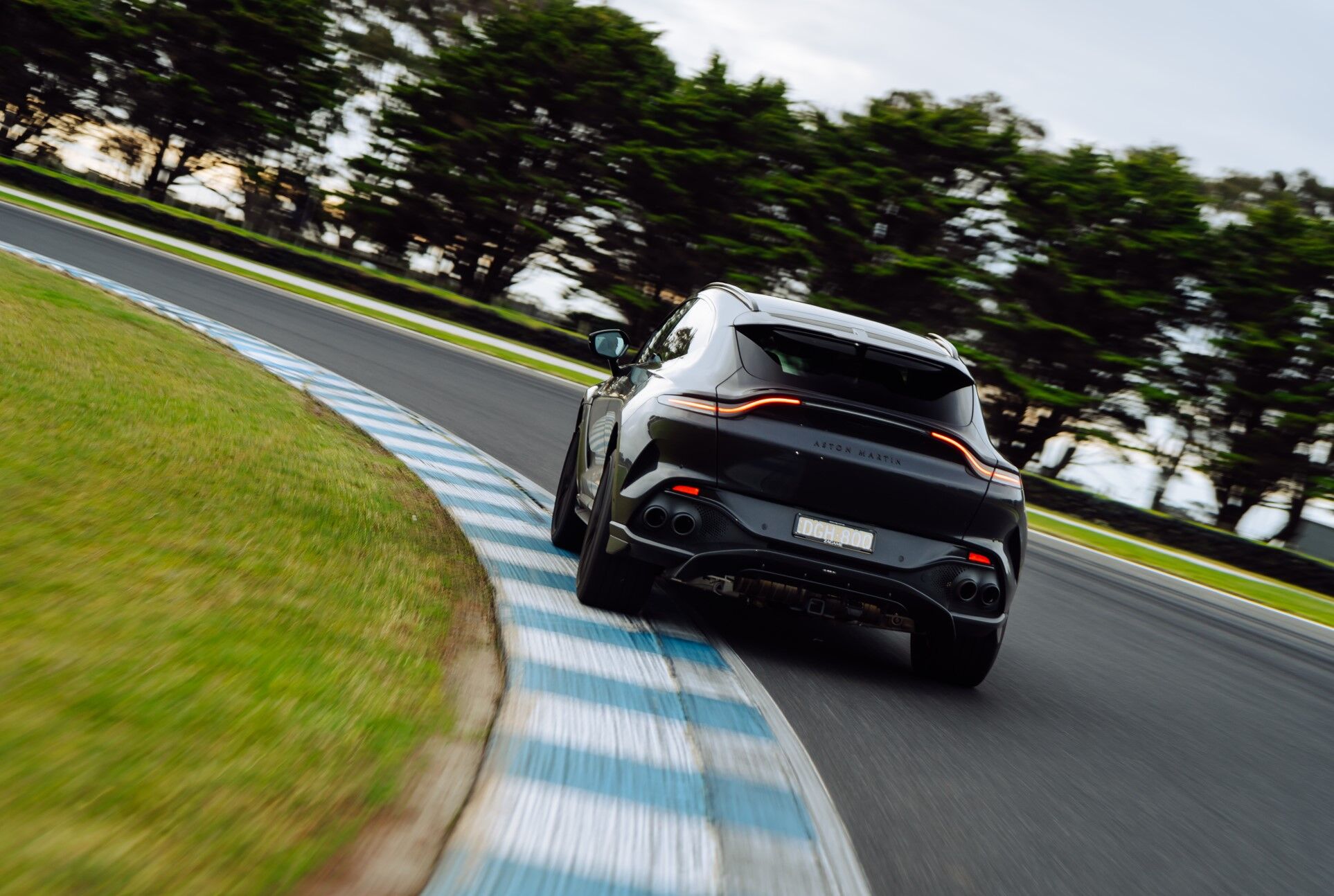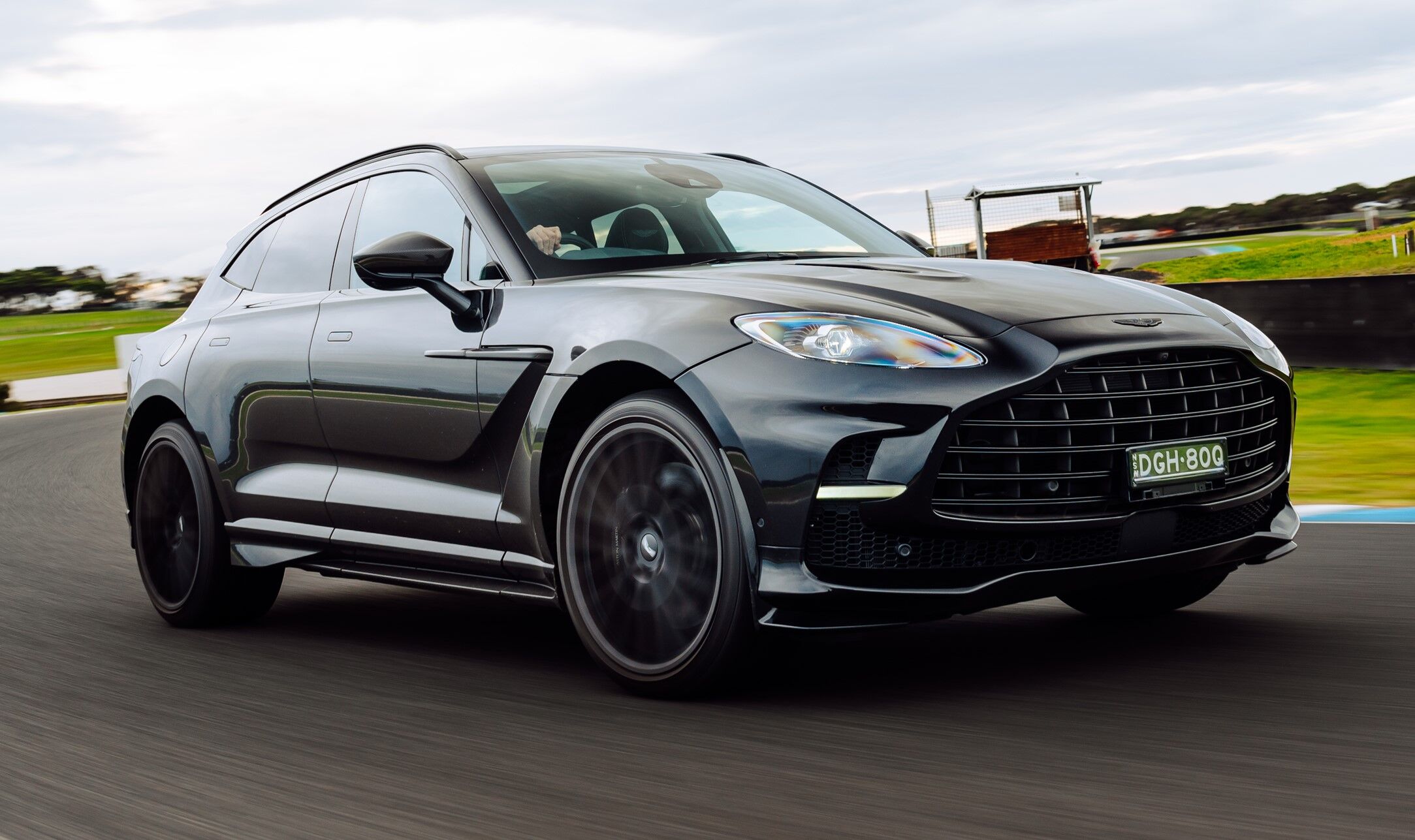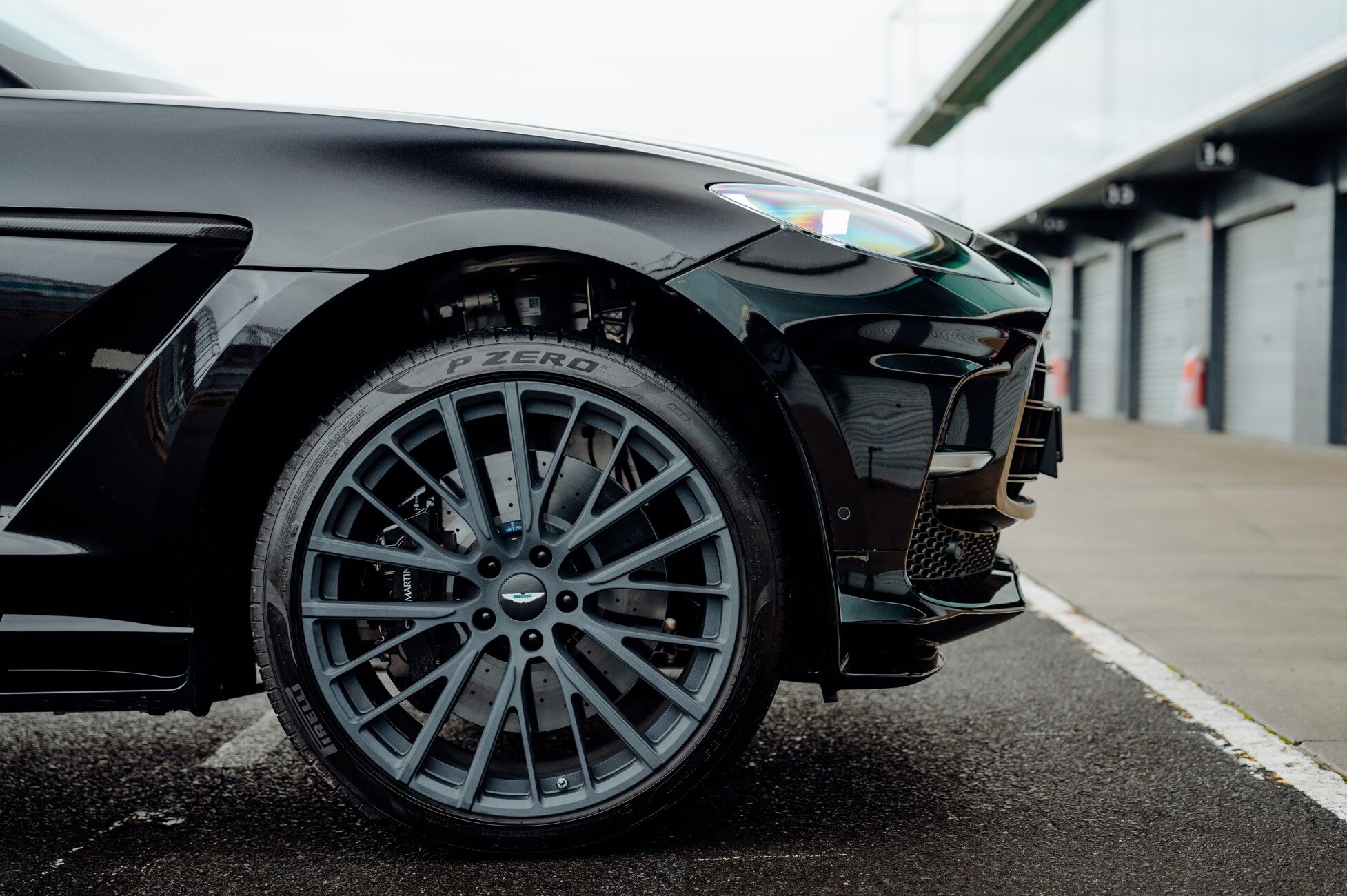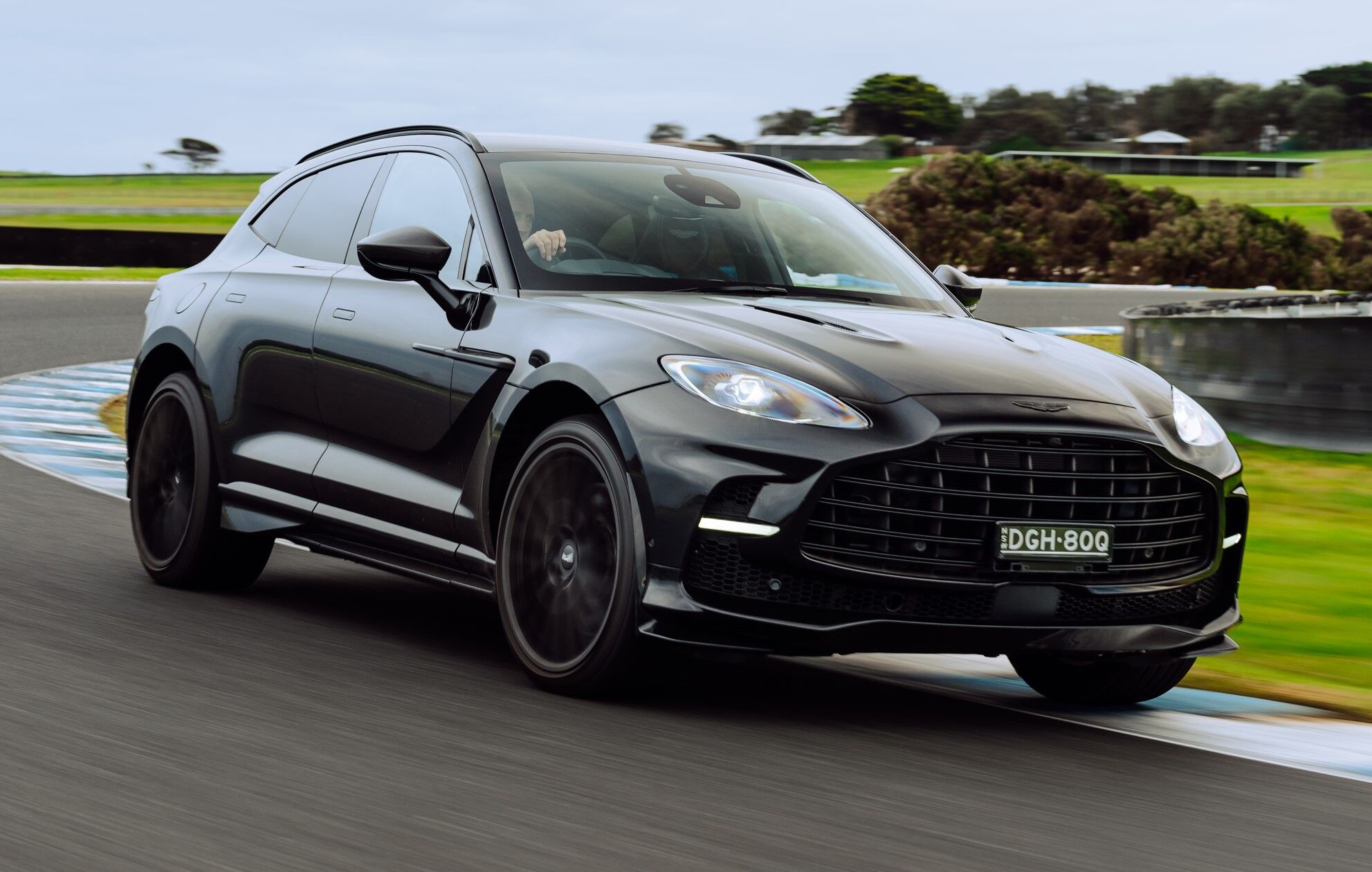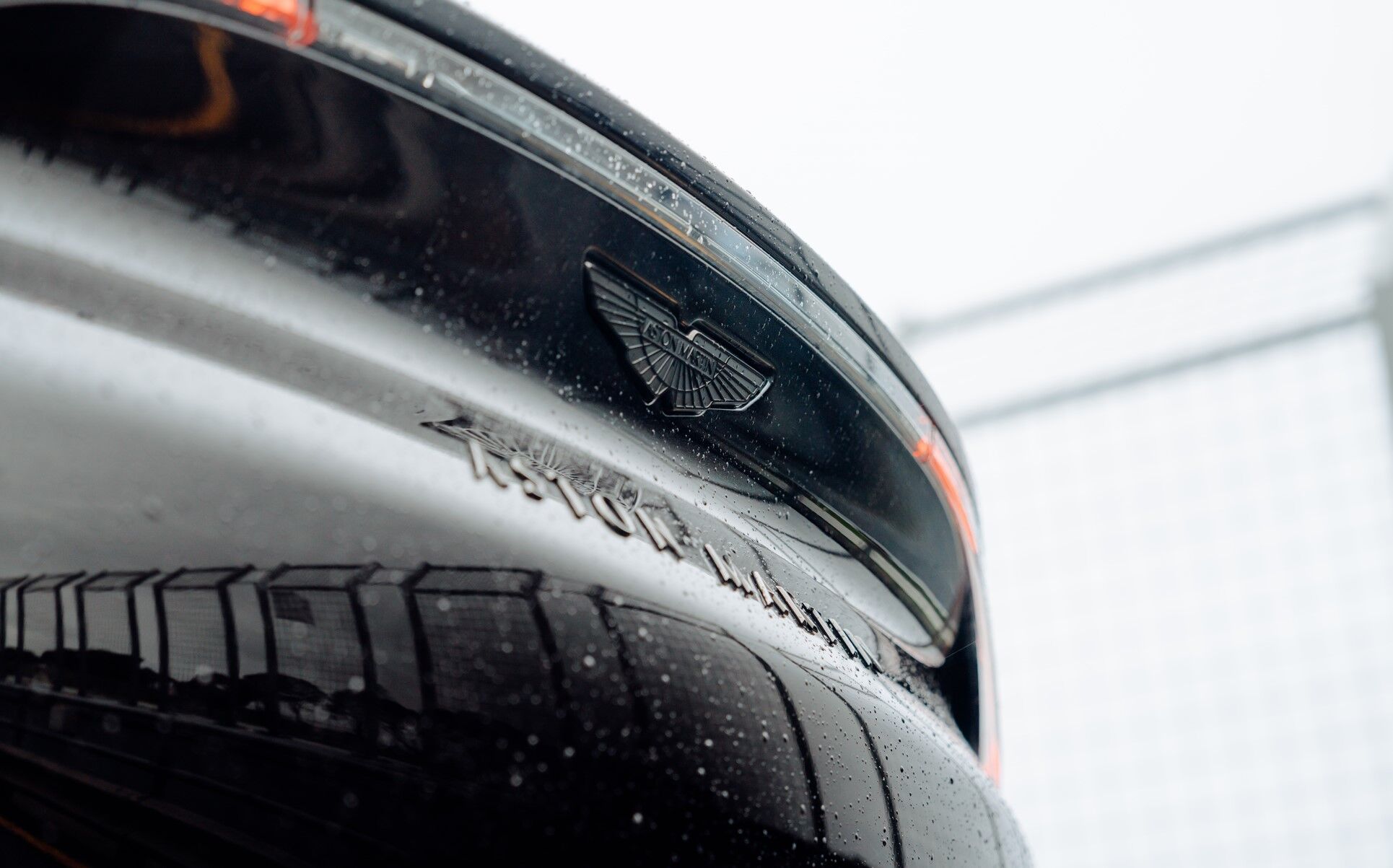We put the 520kW, 900Nm Aston Martin DBX707 through its paces on a wet Phillip Island.
The forecast says rain and 45km/h winds – the forecast is accurate. A shiver runs up my spin as I peak out of the garage at a sodden pit lane but not for the obvious reasons. You see, the last time that I was at Phillip Island in conditions like these, a colleague put a car on its lid 10 minutes after pit lane opened. That car weighed less, had a lower centre of gravity and significantly less power than the Aston Martin DBX707 that awaits me today.
Ramping up the nerves, I’ve just been informed that there’ll be an Aston Martin Vantage GT3 race car on track with me. Circumstances couldn’t be worse in which to test a 2245kg, 520kW Aston Martin billed as the world’s most powerful SUV.
While my nerves percolate, it’s worth a quick refresher on what separates this DBX707 from the ‘regular’ DBX. Firstly, it’s worth acknowledging the name. You might know that the 707 part represents the engine output in metric horsepower but did you know that Boeing granted Aston Martin use of the its trademarked ‘707’ so long as it was always referenced hard against the DBX part, hence DBX707?
Trivia out of the way, the engine is another variant of AMG’s M177 3982cc twin-turbocharged V8. Here it makes the aforementioned 520kW (at 6000rpm) and 900Nm from 2600-4500rpm. These outputs are up 115kW and 200Nm on the DBX, which uses the same engine in a marginally more sane tune. Despite the 2245kg kerb weigh, the DBX707 is said to storm to 100km/h in just 3.3 seconds. In a world of two-point-something hypercars and mega EVs, it’s hard to create much fanfare with a 3.3 but trust me, it’s insanely fast. And the DBX707 doesn’t stop its rush until 315km/h – again, bonkers for a big bus. The regular DBX claims 4.5 seconds to 100km/h and a 291km/h top speed.
For a bit more perspective on just how big the DBX707’s numbers are, consider that it boasts a significantly better power-to-weight ratio than a Porsche 911 Carrera S (232kW/tonne plays 218kW/tonne for the iconic German sports car), is 0.4 seconds quicker to 100km/h and is 7km/h faster flat out.
Aside from the power increase, Aston Martin’s engineers have worked hard to ensure that the DBX707 can harness the outputs of the engine and deliver an engaging experience to the driver. The body is nine percent stiffer and the top suspension mounts are 55 percent firmer. Changes to the three-chamber air suspension system and the damper rates across all drive modes from GT through to Sport + (the Terrain modes are left alone) play their part, too, but a great deal of the higher levels of body control and ride quality can be attributed to the fitment of hydrobushes to the front suspension. Their role is to dampen the forces taken from the front axle to keep the steering as calm as possible and also to manage the unsprung weight that’s inevitable when you fit 23-inch wheels and tyres along with the brakes – standard carbon-ceramics measuring 420mm front and 390mm rear – required to slow a 2245kg SUV with 520kW.
Power is fed through a nine-speed wet-clutch automatic gearbox, and the DBX707 features a shorter final drive so that more of those ratios can be used more of the time.
Key amongst the interior changes is the fitment of a rotary dial to control the driving modes, replacing the buttons on the centre console of the original car. There’s still no touchscreen for the HMI (that’s coming in 2024) but the new sports seats pinch you tighter across the shoulders and the wider range of interior colours go further to lift the already impressive cabin ambience (aside from the Onyx Black example pictured, we drove a vivid Plasma Blue DBX707 with Cote d Azur Blue leather interior).
Having avoided driving a 520kW SUV in tricky conditions as long as seems polite, it is now time to head out onto one of my favourite circuits anywhere in the world. It seems prudent to leave the dampers in their softest setting to give the broad rubber its best chance to dig in and find purchase on the slippery surface. Speaking of the tyres, they are vast Pirelli P Zeroes measuring 285/35 ZR23 up front and 325/30 ZR23 on the rear axle. As for the drivetrain mode, I initially jump from GT to Sport and lock the nine-speed gearbox into manual mode.
The first handful of laps are spent judging available grip and trying to generate a modicum of tyre and brake temperature – aside from the rain and wind, the ambient temperature is resolutely single digits, so the track has got to be close to zero. Aside from a few tiny streams across the circuit, the surface is mercifully free of standing water, so with a resolution to stay off the kerbs, it’s time to dig a little deeper into the DBX707’s latent performance.
So long as the steering wheel is pointed straight, the DBX707’s chassis will allow you to quickly build to full throttle. And boy is it fast when you do, the tacho needle devouring numbers as it sweeps around the dial. Indeed, so quick and keen is the engine to rev, that I’m a fraction of a second late on a shift and the twin-turbo V8 stammers into the limiter. Subdued by a crash helmet, the soundtrack isn’t of the typical AMG blood-and-thunder type, either, so there isn’t the aural cues to help judge your first few shift points.
After another couple of laps, I’m sufficiently dialled into the Aston’s chassis that I bump the dampers up a notch and wind the drivetrain to its Sport+ setting. In slower corners – Honda Hairpin, MG and even Siberia – you have to manage both your entry and exit speeds so that you don’t overwhelm the turn-in grip and post-apex traction. Turning off stability control is (wisely) forbidden, but the electronics allow enough movement – especially under throttle – to surmise that the DBX707 wouldn’t be averse to playful oversteer given space and talent (and a healthy tyre budget).
In faster corners, of which Phillip Island has plenty, the DBX707 works its outside tyres (especially the rear), finding grip and sending confident messages back to the driver. I shouldn’t be enjoying driving such a heavy car so quickly on circuit in such challenging conditions, but each time I alight in pitlane, I’m keen to get back to the driver’s seat rather than hiding in the toilet block hoping that no one will notice my absence.
The conditions take some of the stress out of the day for the brakes, but they still impress with a high and firm pedal, though for some reason I struggle to smoothly bleed out on a couple of occasions causing the nose to pitch up marginally. A colleague makes a similar observation, so perhaps it wasn’t my clumsy left foot.
Given the conditions, Phillip Island’s long Gardner Straight is bookended today by a pretty conservative approach through the fast and long left-hander at turn 12, and a very conservative braking making for the even faster right hander that is Doohan Corner. Even so, the DBX707 thunders to an indicated 247km/h before the self-preservation alarms begin sounding and my brain fires impulses to my left foot to firmly ease into the brake pedal. In dry conditions, who knows what the DBX707 what nail down the straight, but 260-plus isn’t out of the question.
And that GT3? It is already on track when I ease out of pitlane for the last of my sessions, sneaking by me a few corners in. I’m shocked how low it is, or rather, how high I am, as I’ve genuinely forgotten that I’m in a high-riding SUV. While I’m hardly going to claim that I hunt down a GT3 race car in an SUV, I will say that over the next four laps, it eases away much more gradually than expected, perhaps putting as little as 10 seconds on me during that time.
The Aston Martin DBX707 starts in Australia at $428,400 plus on-road costs. Of course, that’s the jumping off point, and the Plasma Blue example mentioned earlier added a cool $100K in options.
While we don’t expect many owners will be hitting the track in their DBX707, don’t ever discount its ability if you find yourself at a trackday with one. Even if you’re in a GT3 car.






